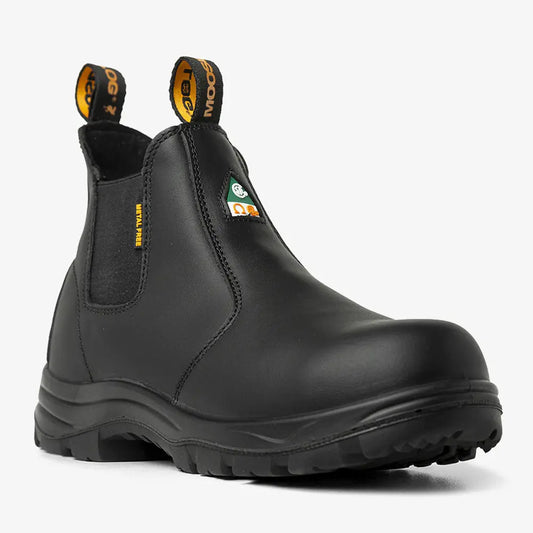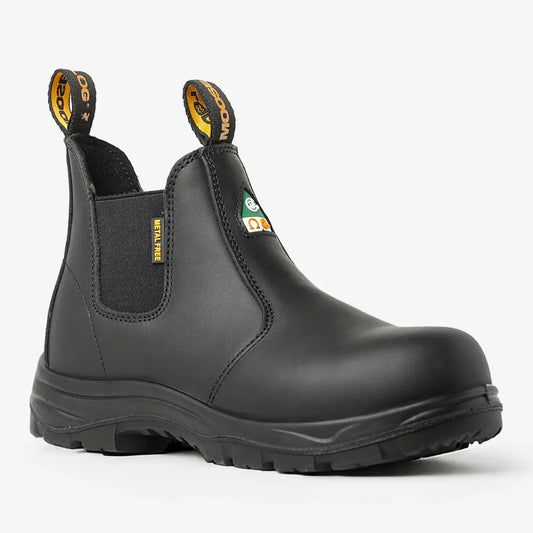
How to Choose the Right Safety Shoes for Comfort and Protection
How to Choose the Right Safety Shoes
Choosing the right pair of safety shoes starts with understanding your work environment. Every job has different hazards, from sharp debris and slippery floors to electrical risks. The best safety shoe protects you from those risks while staying comfortable during long hours on your feet.

Start by checking the certification label. In Canada, look for the CSA green triangle which means the footwear is approved for impact and puncture protection. Workers in construction, warehousing, or manufacturing should always wear CSA approved footwear to meet workplace safety requirements.
Consider the material of the upper, the grip of the outsole, and the weight of the boot. For example, leather offers durability and water resistance, while rubber outsoles provide traction on slick surfaces. A lighter midsole and flexible design make a major difference when standing or walking all day.
Which Safety Shoes Are the Most Comfortable?
Comfort in safety shoes depends on fit, design, and materials. A well-cushioned insole, breathable lining, and balanced weight all contribute to how your feet feel during long shifts. Poorly fitted shoes can cause fatigue and even long term foot issues.
Many modern safety boots now include features like PU or EVA comfort insoles, shock absorbing midsoles, and flexible composite toe caps. Composite toe footwear provides strong protection while reducing weight, making them easier to wear for extended periods.

For maximum comfort, measure your feet at the end of the day when they are slightly swollen from use. Always wear the type of socks you would normally wear at work when trying on boots. A snug heel and toe room that allows slight movement create the right balance between security and flexibility.
How Long Should a Pair of Safety Shoes Last?
The lifespan of safety shoes depends on how often you wear them and the type of work you do. On average, a quality pair of safety boots lasts six to twelve months under regular industrial use. Light use in indoor environments can extend that lifespan to a few years.
If you work on rough terrain or wet surfaces, inspect your footwear frequently. Signs that it’s time to replace your safety shoes include worn-out treads, cracked leather, loose stitching, or damaged toe caps. Once the outsole loses grip, the risk of slips increases significantly.
To extend durability, clean your boots regularly, let them air dry between uses, and avoid direct heat sources. Store them in a cool, dry area when not in use. Proper care keeps the materials strong and extends the protective properties of the shoe.
What Are CSA Safety Shoes?

CSA safety shoes are footwear certified under the Canadian Standards Association’s Z195-14 standard. This certification ensures that the footwear provides adequate protection against impact, compression, and puncture hazards.
Each CSA label has symbols that indicate what the footwear protects against. The green triangle means the boot has both a Grade 1 toe cap and a puncture resistant sole. The white rectangle with an orange Greek omega represents electrical hazard protection.
Canadian employers often require workers to wear CSA approved footwear to comply with occupational safety laws. Always check the inside tongue or tag of your boots to confirm CSA certification before wearing them on a jobsite. For official reference, you can review CSA footwear standards directly on CSA Group’s website.
Are Composite Toe Boots Better Than Steel?
Composite toe and steel toe boots both meet the same CSA impact and compression standards. The main difference lies in their material, weight, and comfort. Composite toes are made from non-metal materials like fibreglass, carbon fibre, or Kevlar. They are lighter, do not conduct electricity, and perform well in cold or hot environments.
Steel toes are heavier and conduct temperature more easily, but they are known for durability and strength. Many workers still prefer them for heavy duty construction or mechanical work. However, for those who spend long hours walking or working indoors, composite toe boots offer a more comfortable experience.
In Canada’s diverse climate, composite toes often perform better in cold weather since they do not transfer temperature to your feet. Regardless of your choice, make sure the boots are CSA certified for full safety compliance.
Where MooseLog Fits
When choosing safety shoes, focus on three priorities: comfort, durability, and certification. Pick CSA approved footwear that fits your job conditions and provides reliable protection without unnecessary weight.
If you need CSA and ASTM certified safety boots with all day comfort, explore MooseLog’s latest collection for men and women. Each pair is tested for impact resistance, puncture protection, and slip performance to meet the highest standards for Canadian workers.




